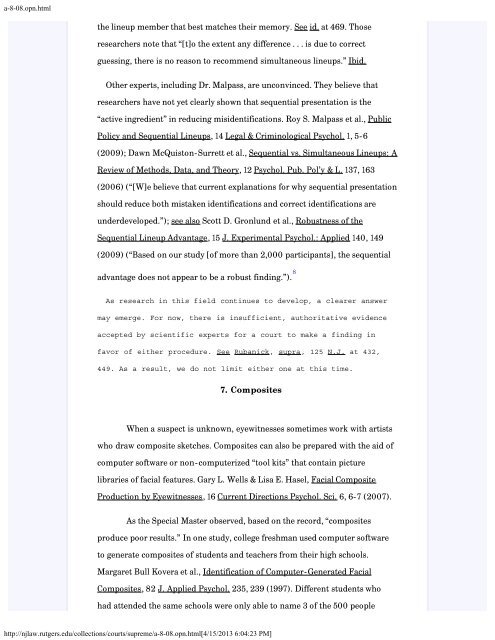State v. Henderson and the New Model Jury Charges - New Jersey ...
State v. Henderson and the New Model Jury Charges - New Jersey ...
State v. Henderson and the New Model Jury Charges - New Jersey ...
Create successful ePaper yourself
Turn your PDF publications into a flip-book with our unique Google optimized e-Paper software.
a-8-08.opn.html<br />
<strong>the</strong> lineup member that best matches <strong>the</strong>ir memory. See id. at 469. Those<br />
researchers note that “[t]o <strong>the</strong> extent any difference . . . is due to correct<br />
guessing, <strong>the</strong>re is no reason to recommend simultaneous lineups.” Ibid.<br />
O<strong>the</strong>r experts, including Dr. Malpass, are unconvinced. They believe that<br />
researchers have not yet clearly shown that sequential presentation is <strong>the</strong><br />
“active ingredient” in reducing misidentifications. Roy S. Malpass et al., Public<br />
Policy <strong>and</strong> Sequential Lineups, 14 Legal & Criminological Psychol. 1, 5-6<br />
(2009); Dawn McQuiston-Surrett et al., Sequential vs. Simultaneous Lineups: A<br />
Review of Methods, Data, <strong>and</strong> Theory, 12 Psychol. Pub. Pol’y & L. 137, 163<br />
(2006) (“[W]e believe that current explanations for why sequential presentation<br />
should reduce both mistaken identifications <strong>and</strong> correct identifications are<br />
underdeveloped.”); see also Scott D. Gronlund et al., Robustness of <strong>the</strong><br />
Sequential Lineup Advantage, 15 J. Experimental Psychol.: Applied 140, 149<br />
(2009) (“Based on our study [of more than 2,000 participants], <strong>the</strong> sequential<br />
advantage does not appear to be a robust finding.”). 8<br />
As research in this field continues to develop, a clearer answer<br />
may emerge. For now, <strong>the</strong>re is insufficient, authoritative evidence<br />
accepted by scientific experts for a court to make a finding in<br />
favor of ei<strong>the</strong>r procedure. See Rubanick, supra, 125 N.J. at 432,<br />
449. As a result, we do not limit ei<strong>the</strong>r one at this time.<br />
7. Composites<br />
When a suspect is unknown, eyewitnesses sometimes work with artists<br />
who draw composite sketches. Composites can also be prepared with <strong>the</strong> aid of<br />
computer software or non-computerized “tool kits” that contain picture<br />
libraries of facial features. Gary L. Wells & Lisa E. Hasel, Facial Composite<br />
Production by Eyewitnesses, 16 Current Directions Psychol. Sci. 6, 6-7 (2007).<br />
As <strong>the</strong> Special Master observed, based on <strong>the</strong> record, “composites<br />
produce poor results.” In one study, college freshman used computer software<br />
to generate composites of students <strong>and</strong> teachers from <strong>the</strong>ir high schools.<br />
Margaret Bull Kovera et al., Identification of Computer-Generated Facial<br />
Composites, 82 J. Applied Psychol. 235, 239 (1997). Different students who<br />
had attended <strong>the</strong> same schools were only able to name 3 of <strong>the</strong> 500 people<br />
http://njlaw.rutgers.edu/collections/courts/supreme/a-8-08.opn.html[4/15/2013 6:04:23 PM]
















